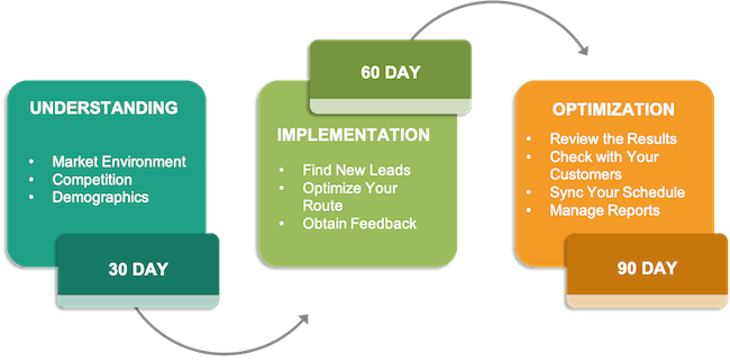
Creating a 30 60 90 Sales Plan [Step by Step Guide]
 Updated on
Updated on
 By Carlos Correa
By Carlos Correa
Carlos Correa
Carlos has been involved in the sales space for well over ten years. He began in the insurance space as an individual sales agent, managing teams as s...
learn more
Carlos Correa
Carlos has been involved in the sales space for well over ten years. He began in the insurance space as an individual sales agent, managing teams as s...
Table of Contents
Table of Contents
So you're a sales rep starting a new job, hey?
Or maybe you've just been given a shiny new territory to work with and want to show your boss that you have what it takes to crush it.
We get it, you're bright-eyed and bushy-tailed, ready to hit the ground running and make those sales.
But you've got to be smart about it.
There's a well-known principle that salespeople are often aware of, called the Pareto principle, that states that 20% of a company's salespeople produce 80% of that company's overall sales.
You obviously want to be part of that 20%, but before you do that, you've got to learn the ropes, which includes discovering which metrics are important to the company and yourself, learning about your customers, and otherwise figuring out how you can sell the most effectively.
Sounds like a great objective, but what's the best way to achieve it?
By following a comprehensive sales plan.
Because as every great salesperson knows, you can't just walk into a new sales position, whether that's with a new company or taking over a sales territory you've never worked with before, without a solid plan on how you're going to tackle sales.
A sales plan is basically a schedule that helps you prioritize tasks and set specific targets and objectives that you'll want to achieve.
But to be effective, you want to create more than just a general outline. You want to get specific by digging out your SMART goals, researching, and much more. That's where the 30 60 90 Sales plan comes in.
Let's start by defining what it is and then go from there.
What is a 30 60 90 Sales Plan?

A 30 60 90 sales plan is a strategic outline that maps out a salesperson's first three months in a new role. It's designed to help individuals gradually integrate into their position, setting clear goals and milestones across three distinct phases: the first 30 days, the next 30, and the final 30 days.
This structured approach allows new hires to onboard effectively, build strong foundations, and start contributing to sales targets within 90 days. Whether you're a seasoned professional or a beginner, a 30-60-90 day sales plan helps clarify expectations and streamline success.
You can customize your sales plan to suit your needs and the needs of the business you work for, but a typical 30 60 90 day sales plan will look something like this:

|
Days 1-30: Understanding |
Days 31-60: Strategy & Planning |
Days 61-90: Execution & Performance |
|
Focus on training and gaining product knowledge. You'll dive deep into understanding company culture, researching the market, and familiarizing yourself with the sales processes. Build rapport with key team members and complete initial training. |
In this phase, you'll start developing sales strategies, building relationships with prospects, and setting intermediate goals. Key activities include shadowing senior reps, planning outreach campaigns, and identifying potential clients. |
The final phase emphasizes executing sales strategies. This is where you start actively selling, closing deals, and tracking your performance. The focus is on integrating fully into the sales team, achieving your first sales quota, and building a sustainable pipeline. |
1. 30-Day Phase: Learning and Understanding
In the first 30-day phase of the 30 60 90 day sales plan, the focus is on learning. This period is all about immersing yourself in the company culture, familiarizing yourself with the products or services, and understanding internal processes. Here, you're laying the groundwork to ensure a smooth transition into the next phases.
|
Key Activities |
Description |
|
Training and Onboarding |
Dive deep into the product or service offerings. Understand how they solve customer pain points, and know your unique selling points inside and out. |
|
Market Research |
Analyze competitors, market trends, and target audience profiles to understand the landscape. |
|
Sales Process Orientation |
Familiarize yourself with the sales funnel, customer relationship management (CRM) tools, and internal sales workflows. |
Initial goals:
- Meet with key team members and stakeholders to establish rapport.
- Complete all mandatory training sessions.
- Start conducting product demos or mock sales calls to solidify product knowledge.
This first phase helps you build a solid foundation before diving into sales execution, ensuring you're well-versed in the company's offerings and market positioning.
2. 60-Day Phase: Strategy and Planning
After the learning phase, the 60-day phase shifts toward crafting your game plan. Now that you understand the product and market, it's time to begin forming relationships and laying down sales strategies. You should also begin setting intermediate goals that will help ensure you're on track to hit sales targets in the final phase of the 30 60 90 sales plan.
|
Key Activities |
Description |
|
Sales Strategy Development |
Use your market insights to craft personalized strategies that resonate with your target audience. |
|
Relationship Building |
Begin reaching out to prospects, attend networking events, and start nurturing leads. |
|
Mentorship and Shadowing |
Work alongside senior sales reps to observe their techniques and gain practical experience. |
Intermediate goals:
- Identify key clients or accounts to target during your outreach.
- Develop a personal sales pipeline, including early-stage prospects.
- Plan outreach campaigns, possibly setting up introductory calls or meetings with key prospects.
At this stage, you're actively working on aligning your strategies with company goals, setting the stage for execution in the final phase.
3. 90-Day Phase: Execution and Performance
In the final 90-day phase, it's time to execute. By now, you should be fully integrated into the sales team and actively engaging in sales activities. The primary goal here is to start closing deals and meeting your sales quotas. This phase is where you truly begin to demonstrate the value you've been preparing to deliver.
|
Key Activities |
Description |
|
Active Selling |
Engage with prospects, present product demos, and begin negotiating deals. |
|
Performance Tracking |
Start tracking your performance metrics (e.g., conversion rates, lead generation). |
|
Sales Pipeline Management |
Continue building and refining your sales pipeline to meet future goals. |
Long-term goals:
- Close your first few deals and hit your first sales quota.
- Establish a sustainable sales pipeline that will contribute to ongoing success.
- Begin setting long-term performance goals, such as improving closing ratios or expanding into new markets.
Benefits of a 30-60-90 Sales Plan
It's crucial that new salespeople, whether they are new to the company or just new to a particular sales territory, have all the sales tools and information they need to be successful. Part of that includes creating a 30 60 90 sales plan, which provides the following benefits:
Helps Make a Good First Impression
Sales are all about first impressions, and there's a lot to go around in a sales environment. Not only does the salesperson want to make a good first impression on their customers, but also on their manager as well, especially if they've just started a new job. On the other hand, a sales manager should want to make a good first impression on a new salesperson, to show them that "this is a good company to work for and you have great earning potential here."
A 30 60 90 sales plan helps foster great first impressions all around:
- If a salesperson creates a 30 60 90 sales plan presentation to show their manager, it highlights that salesperson's commitment to selling, complete with measurable goals
- If a sales manager creates a 30 60 90 sales plan for a new salesperson, it shows transparency with expectations and a commitment to ensure that the employee gets a good start
- Armed with a comprehensive sales plan, a salesperson is likely to be more confident because they have structured, clear expectations to follow rather than being thrown to the wolves with unclear expectations and goals
Sets Expectations During Onboarding
Any employee, salespeople included, should never be in doubt about what is expected of them in a new role. With a 30 60 90 sales plan, whether the salesperson creates it themselves and receives manager approval, the plan is created by their manager, or the creation of the plan is a joint effort, clear expectations regarding learning, sales, and process optimization can be clearly established from the beginning.
Helps Salespeople and Managers Keep Track of Performance in a New Territory or Job
Surprises are good for parties, but not so much for your sales job. A 30 60 90 day plan for a new sales territory or job is the perfect way to keep track of performance. As data from outreach, leads, and sales comes in, everyone can clearly understand how things are going and make adjustments as needed. This means that if there's an issue, let's say with the effectiveness of outreach or the number of overall closed sales, it can be identified quickly, and action can be taken to rectify it.
Helps with Time Management
When a clear map of goals and timelines to reach them is available, it's much easier for salespeople to stay on track with their deliverables and ensure there's enough time available to reach important milestones.
For example, suppose a milestone is set at the 30-day deadline for a meeting between a sales manager and salesperson to determine where they're at with understanding their territory, customers, and/or the company's products or services via a report. In that case, the salesperson knows that they must set aside time to gather their notes and potentially create a presentation in preparation for that meeting.
Allows Data-Driven Decisions to be Made Regarding Sales Strategy
Not every approach to sales will result in smashing success, and that's ok. By using data from a 30 60 90 sales plan, data-driven decisions can be made regarding adjustments to your sales strategy, giving the salesperson the best opportunity to fine-tune their approach to sales over time.
5 Steps to Create a 30/60/90 Sales Plan

1. Research Your Company, Competitors, Customers, and Products or Services
You won't get very far in sales if you don't do your homework first. Customers respond well to salespeople that demonstrate competence by taking the time to do their research on the customer, their pain points, and the company they work for beforehand.
With Ringy, for instance, a salesperson can see conversation history via a specific customer dashboard. This is especially useful if said salesperson just took over new territory and needed to get the lowdown on the company's current relationship with that territory's customers. This information is extremely valuable for showing a customer that you've taken the time to do your homework and learn about their previous history with your company, rather than relying on them to tell you everything during your first conversation.
In addition to researching your customers, you should also understand your company's products, services, and competitors well. With this information, you can make effective recommendations to your customers that make sense and be prepared to face potential objections.
2. Identify your Own Priorities
You'll want to make sure that your own professional priorities are clear in your 30 60 90 day sales plan. It's true that during your first 30 days, your main goal is likely to learn about your company, the products that your company sells, and its competitors, which should be listed in your plan. However, it's also likely that you'll want to get more specific with what exactly your priorities should be throughout your 30 60 90 day plan, like completing onboarding and training within the first week, becoming familiar with the company's values and mission, etc.
3. Be Realistic with Setting Goals
You don't want to sell yourself short, but you don't want to be too ambitious too quickly either. When you're developing your 30 60 90 day sales plan, you have to be able to balance which goals you can realistically accomplish without selling yourself short. You might need some input from experienced sales reps or your manager here to set achievable goals, especially if you're new to the company.
4. Ensure Your Sales Goals Align with Your Company's Goals
Do you know and understand your company's goals? Sure, your company wants you to sell, but chances are the actual company goals are more robust than that, like increasing overall revenue year over year by at least 20%. So let's say you're part of a team of 10 salespeople, and your territory historically earns 2.5% of overall company sales. That's a big territory and a lot of sales you're responsible for, so if you set your own sales goal at let's say 1.5% for the year, that likely isn't needed to cut it, or it'll put more pressure on the rest of your team to make up the difference.
5. Ensure Your Goals Align with Your Team
Speaking of sales teams, it's important to ensure that your goals also align with the rest of your team. Going back to our previous example, let's say that you set a sales goal that was a bit lower than your territory typically produces within a given year — but you've done so because a few of your big accounts in the area have downsized their operations or moved on to a competitor.
Sales territories don't stay static forever, there are always changes with accounts with either client moving on or new entrants into the area. That's why it's important to discuss these changes with the rest of your team (and chances are they're experiencing the same fluctuations) to ensure that everyone's on the same page with regard to expectations and goal setting.
30 60 90 Days Sales Plan Examples

Example #1: 30 60 90 Day Plan for New Sales Territory
Day 1-30:
- Determine any competitors that exist in your territory
- Determine customer demographics information and industries that they work in
- Determine how many potential customers are currently in your territory, which is the Total Addressable Market (TAM) and where each account is located within that territory
- Note if there is any new accounts that have been added since the territory was created
- Determine the geographic boundaries of the territory (where it starts and ends)
- Categorize customer accounts based on overall spending, or Customer Lifetime Value (CLV)
- Determine potential spending power of new and existing customers
- How many other sales reps are assigned to your territory (if any) and what their current relationships are with various accounts
- How big your Share of the Market (SOM) is, and how much your company can reasonably acquire
- If there's any accounts that have untapped opportunities for sales, for instance new locations, recent growth (this would be the Serviceable Available Market, or SAM)
Day 31-60:
- Analyze potential leads, and nurture existing accounts to further qualify and prioritize them
- Further segment your market into categories using SMART goals (in the case of sales, you're looking at Sustainability, Measurability, Accessibility, and Responsiveness)
- Conduct a SWOT (Strengths, Weaknesses, Opportunities, Threats) analysis of your territory
- Create action items (e.g. add at least one new customer account in the next month, develop a relationship with the top account in the territory)
Day 61-90:
- Gather data (likely from your sales CRM) and adjust strategies by seeing where you and your team saw success, and where you didn't
- Review individual accounts and determine if there's any areas where service could be improved
- Implement sales automation tools as needed to streamline any aspect of your sales process (e.g. send an automatic email when a customer successfully completes a lead gen form on your website)
Example #2: Sales Onboarding 30 60 90 Day Plan
- Complete onboarding documents and gain an understanding of company values and mission
- Develop an understanding of corporate policies and procedures, your role on the sales team
- Develop at least an intermediate level of knowledge of products and/or services
- Knowing where the product or service your company offers fits within the target market
- Knowing who your customers are, including reviewing marketing personas
- Developing relationships with key stakeholders within your company, such as customer support management, sales leadership, and other sales team members
- Reviewing any relevant CRM data
Day 31-60:
- Starting to develop leads, and keeping track of them as they move through the sales funnel
- Have a more in-depth understanding of your company's products and/or services (depending on complexity, this could still be considered intermediate-level knowledge, but starting to get into a high-level understanding)
- Development of an outreach strategy
- Listening in on ongoing sales calls with experienced team members
- Making a few sales calls of your own, with a manager available for coaching if needed (with Ringy, a manager can listen in on sales calls and provide real-time coaching without the customer being aware)
Day 61-90:
- A complete list of managed leads
- A set daily schedule for prospecting and sales calls
- Received feedback from a sales manager and taken steps to action it if necessary
- Closed at least one deal
- Established relationships with a few key customer accounts
Example #3: 30 60 90 Sales Plan for Team Leads and Managers
Day 1-30:
- Gain a complete understanding of company goals, mission, and values, as well as the products and/or services you and your team will be selling
- Gain a complete understanding of the company's policies, procedures, and current sales processes
- Learn about your team, including their professional strengths and weaknesses, and identify any opportunities for improvement, including additional training
- Learn which accounts and territories each member of your sales team is responsible for, including how much revenue each customer account brings in, and if there are any identifiable opportunities for increase CLV from any of these accounts
- Talk to your sales team, discover any current pain points, process improvements, and determine what is needed for your team's success
Day 31-60:
- Establish relationships with key stakeholders within the company
- Work closely with marketing to align sales strategy with marketing endeavors, and ensure that you build a lasting and solid relationship
- Work to establish a trusting professional relationship with your team by being transparent, admitting when you don't know information, and demonstrating your skills as a sales manager
- Continue to monitor and gather data regarding sales and team performance
Day 61:90:
- Gather data and prepare it for analysis
- Use data to make decisions regarding effectiveness of sales strategies, including what is going right and what is going wrong, where improvements can be made, and any opportunities for future growth
- Review each team member's performance and ensure that they are staying on track
- Create and communicate any changes in sales priorities, process improvements, strategies, and any other changes that your sales team should be aware of
30 60 90 Days Sales Plan Templates

1. Sales Onboarding 30 60 90 Day Plan Template
HubSpot's 30 60 90 sales plan template keeps information simple and straightforward with an easy-to-follow format:
What You Want to Accomplish Within 100 Days
A new hire should accomplish the following expectations within the first 100 days of their employment as a sales rep (list as many expectations as necessary):
- Expectation #1
- Expectation #2
- Expectation #3
Month 1: Date - Date
Building off of the list of expectations you created above, the first month should focus on the salesperson getting oriented with the company and getting situated in their position. Sales goals shouldn't be the focus here, as the main goal within the first 30-days should be the salesperson learning about the company, the products and/or services they'll be selling, and their customers.
Goals, deliverables, measurements for success, and resources provided should all be listed:
- Goals: Goal 1
- Deliverables and how success is measured: How success is measured
- Resources: Links to any helpful resources
Download HubSpot's Sales Template
2. 30 60 90 Sales Territory Plan Template
The 30 60 90 day plan for new sales territory template from Xtensio helps you create a visually appealing plan that can be easily shared with stakeholders and includes:
First 30 days:
- Learning about customer personas
- Identifying and learning about competitors
- Identifying top accounts
31-60 Days:
- Defining sales goals and Key Performance Indicators (KPIs)
- Identifying top leads
- Building a sales schedule
60-90 Days:
- Gathering qualitative feedback
- Analyzing results
Download Xtensio's Sales Template
3. 30 60 90 Day Account Executive Plan Template
The 30 60 90 day plan for account executives from Leadfeeder is designed to help new account executives onboard smoothly, building a strong foundation for future success by focusing on customer relationships, sales skills, and goal-setting.
First 30 Days:
- Focus on understanding the product, target market, and internal processes. This includes reviewing existing sales strategies and learning the CRM systems.
- Spend time observing senior account executives and sales leaders to learn best practices.
- Introduce yourself to clients and internal stakeholders to start building rapport.
31-60 Days:
- Begin building a sales pipeline by identifying prospects and initiating outreach.
- Use insights gained from the first 30 days to develop tailored strategies for your accounts.
- Start having introductory calls and meetings with clients, positioning yourself as a trusted advisor.
60-90 Days:
- Begin actively managing accounts, including regular check-ins and follow-ups with clients.
- Focus on meeting sales targets, such as closing deals and maintaining pipeline velocity.
- Regularly assess what's working and make necessary adjustments to meet long-term goals and quotas.
Conclusion
Preparing for a new sales job or taking over a new sales territory in your company can be daunting, but with a well thought out 30 60 90 day sales plan, you can ease stress by setting out expectations in advance.
When it comes to managing your customers, leads, and other sales and marketing initiatives, you'll need a sales CRM that works with you and your sales process. That's where Ringy comes in.
Request a Demo with Ringy today, and we'll walk you through our software.

Skyrocket your sales with the CRM that does it all.
Calling? Check. SMS? Check. Automation and AI? Check. Effortlessly keep in touch with your customers and boost your revenue without limits.

Take your sales to new heights with Ringy.
Sales in a slump? Ringy gives you the tools and flexibility you need to capture leads, engage with them, and turn them into customers.
Subscribe to Our Blog
Enter your email to get the latest updates sent straight to your inbox!
Categories
Related Articles



































































































